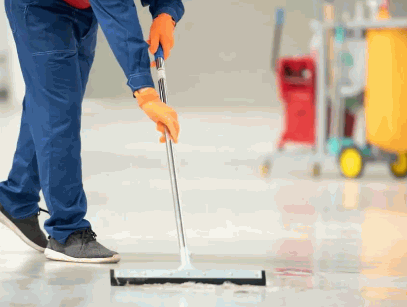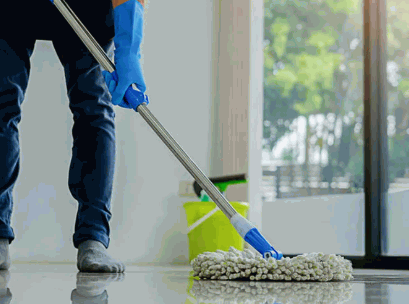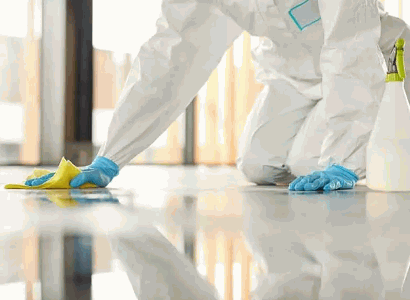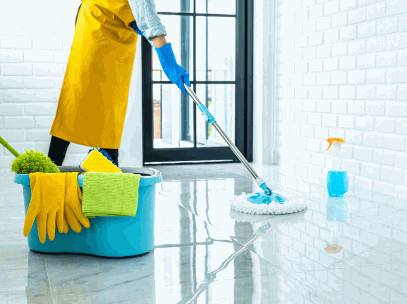Table Of Contents
Epoxy flooring is popular for its durability and good looks.
To keep it looking great, regular cleaning and maintenance is key. Here, we'll cover the steps for cleaning epoxy flooring and some tips to get rid of dirt, stains, and other debris.
- Sweep or vacuum regularly to remove loose dirt and particles. This stops them from damaging the epoxy coating. Use a dust mop for any missed dust or small debris.
- For stains or spills, use a mild detergent or special epoxy floor cleaner. These cleaners are designed specifically for epoxy and can remove tough stains without hurting the coating. Follow the manufacturer's instructions and don't use harsh chemicals or abrasive scrub brushes.
- For high-traffic areas where dirt and grime accumulate more often, use a commercial-grade floor buffer with a soft pad attachment. This brings back the shine and luster of the epoxy while also removing ground-in dirt and stains. Sweep and clean the area first to keep any debris from getting stuck in the pad.

Importance Of Cleaning Epoxy Flooring
Cleaning epoxy flooring is essential for keeping it long-lasting and aesthetically pleasing. Ignoring regular cleaning can cause dirt, dust, and stains to accumulate, which can ruin the flooring over time.
- Routine cleaning keeps epoxy flooring durable and strong.
- It stops the build-up of dirt, debris, and stains that can be challenging to get rid of if left alone.
- Cleaning also makes the flooring look better by reviving its shine and luster.
- It eliminates contaminants such as grease and oil, which ensures a safer environment with better traction.
- Cleaning lowers the risk of slip and fall accidents, especially in commercial or high-traffic areas.
- Keeping an epoxy floor clean shows a business or homeowner's commitment to hygiene and professionalism.
As well as these advantages, there are other important facets to consider when cleaning epoxy flooring. For example, using non-abrasive cleaners that are specifically designed for epoxy floors helps preserve their life. Refraining from harsh chemicals or scrubbing tools that may harm the surface is essential for maintaining its quality.
Preparing For Cleaning
Ready to clean epoxy flooring? Follow these 3 simple steps for a successful clean:
- Clear the area. Get rid of furniture, objects, or debris on the floor. Store delicate items somewhere safe.
- Sweep or vacuum. Remove loose dust and dirt with a soft-bristled broom or vacuum.
- Choose the right cleaner. Use mild detergent or epoxy cleaner, as per the manufacturer's instructions.
Now you're ready for the actual cleaning! Plus, here are some extra tips:
- Use a soft mop or microfiber cloth to apply cleaner.
- Rinse after cleaning to remove residue.
- Schedule deep cleans to remove grime buildup.
- Clean spills/accidents immediately.
- Apply protective coating or wax after cleaning.
Follow these suggestions for a pristine epoxy floor that looks great and lasts long!
Sweeping & Vacuuming
Sweeping and vacuuming are an absolute must for keeping your epoxy floor clean! Here are some tips from expert cleaners to remember:
- Use a soft-bristled broom or dust mop to remove debris from the epoxy-coated surface. Make sure to sweep back and forth, covering all areas.
- For bigger particles or tough stains, use a vacuum cleaner that has a soft brush attachment. Avoid vacuums with rotating brushes or beater bars.
- Replace or empty the vacuum bag regularly to prevent dirt from being spread about.
Don't forget to clean the beneath furniture and move it around occasionally. This will stop dust from accumulating and ensure a thorough cleaning.
Proper sweeping and vacuuming techniques are important for keeping your epoxy floor looking its best! Did you know? According to CleanLink, sweeping helps avoid scratches on epoxy floors, increasing their lifespan.

Removing Stains & Spills
Removing stains and spills from epoxy flooring can be tricky. However, the right techniques and products can help you clean your epoxy floor and make it shine again. Here's a 3-step guide to remove the stains and spills.
| Step | Details |
|---|---|
| 1 | Identify the stain: First, figure out the type of stain or spill you're dealing with. Different stains require different cleaning methods. Oil-based stains need degreaser while food stains need a mild detergent. |
| 2 | Prepare the cleaning solution: Once you've identified the stain, prepare the cleaning solution. Follow the instructions on the package for the cleaner. Use only recommended cleaning products that are safe for epoxy surfaces. |
| 3 | Clean the stained area: Now that the solution is ready, use a soft-bristle brush or mop to apply the solution. Scrub lightly in a circular motion to remove the stain. Rinse with clean water afterward. |
If some stains are stubborn, you might need multiple attempts or specialized stain removers. In this case, seek professional help or ask an expert for advice.
To prevent stains and spills in the future, here are some tips:
- Use rugs or mats: Put rugs or mats in high-traffic areas or areas prone to spills. This will protect your epoxy floor from dirt and other staining agents.
- Wipe up spills: Immediately wipe up any spills to stop them from seeping into the surface. Use a damp cloth or sponge for liquids and a soft brush for sticky spills.
- Regular maintenance: Create a regular cleaning schedule for your epoxy floor. Sweep or vacuum regularly and mop using a gentle cleaner diluted in warm water.
By following these tips, you can keep your epoxy floor clean and shiny while preventing staining or spilling. Remember, prevention is the key when it comes to maintaining an impeccable epoxy floor.

Mopping The Floor
Epoxy flooring is durable and resistant to chemicals and stains. To clean it properly, here are the 5 steps to follow:
- Put warm water and a pH-neutral cleaner for epoxy floors in a bucket.
- Soak a mop in the bucket. Squeeze out excess water and start mopping from a corner.
- Use circular motions to get rid of dirt and grime.
- Rinse the mop in the cleaning solution to stop dirt from spreading.
- Let the floor air dry or use a dry mop to take away leftover moisture.
To protect the epoxy surface, don't use abrasive cleaners or tools. Use soft-bristle brushes or microfiber mops instead.

Drying & Finishing Touches
- Sweep or vacuum up any debris or dirt on the floor.
- Mix mild soap or detergent with warm water in a bucket.
- Dip a mop or soft cloth in the soapy solution and wring out the excess liquid.
- Mop the entire floor, paying extra attention to any stains or spills.
- Rinse the mop or cloth in clean water and mop again to remove any soap residue.
- Be mindful not to use abrasive cleaners or tools that could damage the epoxy.
- Let the floor air dry completely before walking on it or putting furniture back.
A thin layer of wax specifically designed for epoxy floors can enhance the shine and provide added protection.
Drying times may vary based on humidity and airflow. So, be patient and give it time to dry before finishing the cleaning.
The concept of epoxy flooring started in World War II on military aircraft hangar floors. As technology progressed, cleaning methods for epoxy flooring evolved to maintain its look and durability.
Maintenance Tips For Long-lasting Epoxy Flooring
To ensure the long-term beauty and functionality of epoxy flooring, proper maintenance is essential. Here are some tips to keep your epoxy floors looking their best:
- Regularly sweep or vacuum the floor to remove dirt and debris.
- Mop the floor with a pH-neutral cleaner and warm water. No harsh chemicals!
- Clean up any spills immediately with a soft cloth or paper towel.
- Lay mats or rugs in high-traffic areas to protect the flooring.
- Lift furniture instead of dragging it across the epoxy surface.
- Periodically inspect for any signs of wear or damage.
Moreover, don't use abrasive cleaners or scrub brushes as they may cause scratches. Also, extreme temperatures can affect the durability of epoxy floors, so avoid exposing them to excessive heat or cold.
Delve into: Can Epoxy Flooring Be Used Outdoors

Conclusion
It's time to wrap up our discussion on how to clean epoxy flooring. Remember: regular maintenance is key to preserving its beauty and longevity. The right cleaning solution and method are important.
Use a pH-neutral cleaner specifically designed for epoxy floors. This will be gentle yet effective in removing dirt, stains, and grime. Use a soft-bristle broom or a dust mop to sweep or dry-mop the floor regularly. For deeper cleaning, use a microfiber mop or a soft nylon brush. Don't use harsh chemicals or abrasive tools. Also, don't expose your floor to excessive heat or direct sunlight.


